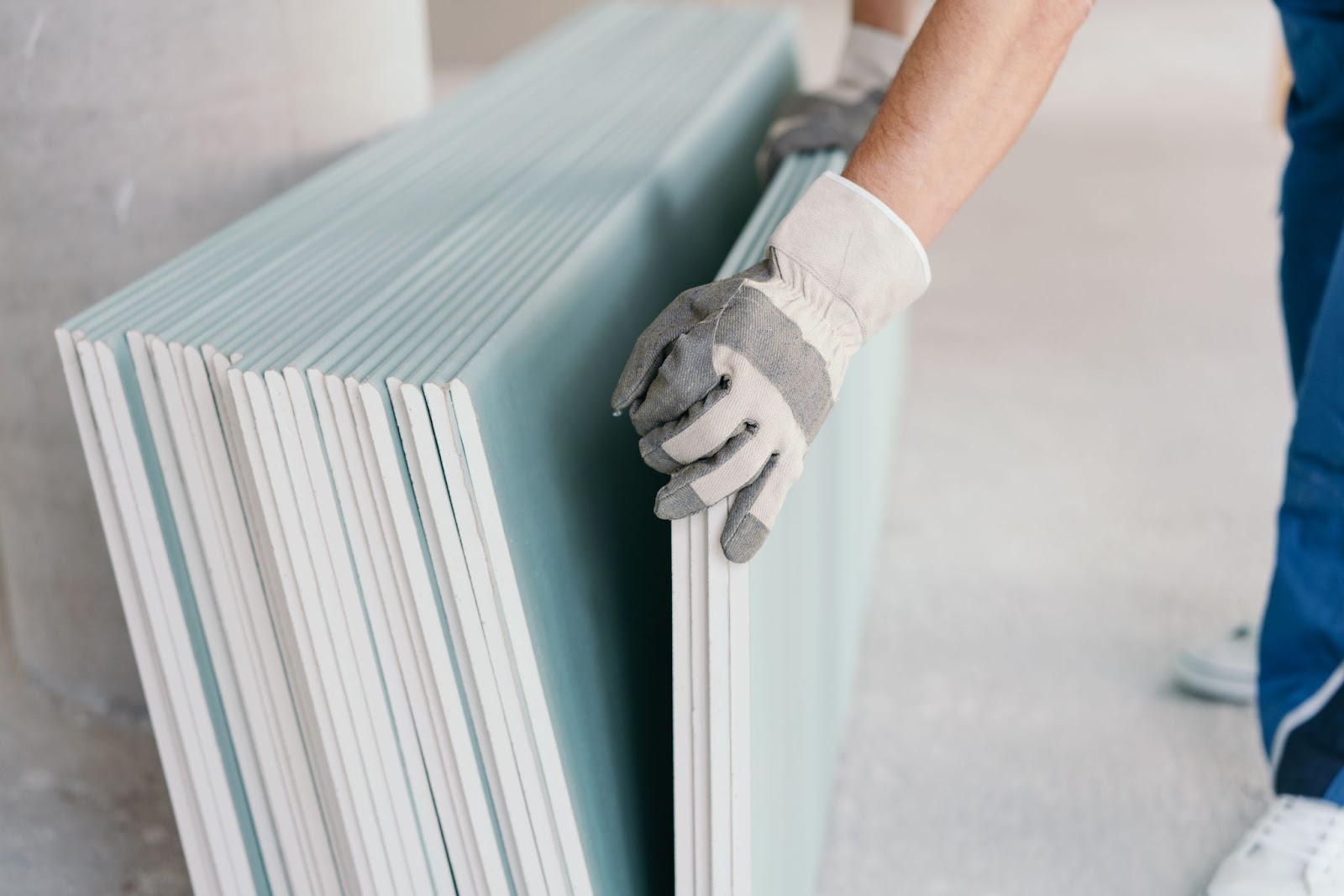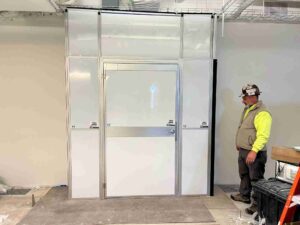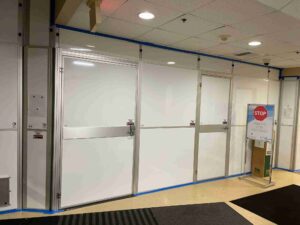Types of Temporary Construction Walls and Their Pros and Cons

When it comes to construction and renovation projects, there’s no question that clean environments increase safety, organization, and productivity. This makes temporary construction walls a vital part of any construction project.
Temporary construction walls can have a significant impact on dust control, sound disruptions, timeline, budget, and the environment. But not all temporary construction walls are created equal.
Below, we lay out the four major types of temporary construction barriers and how they measure up, so you can decide which is the best fit for your next project.
Types of Temporary Construction Walls
Drywall Temporary Construction Walls
Historically, drywall has been one of the most popular choices for temporary construction barriers. It remains a conventional choice for several reasons. This solution:
- Offers multiple finishing level options, including ones that can give the look of a permanent wall structure
- Can reduce heat transfer, which can help manage indoor temperatures
- Absorbs sounds, reducing disruptions for occupants
The cost of installing temporary drywall barriers can vary based on:
- Labor required
- Duration of installation
- Level of finish
- Disposal solutions
On the surface drywall may seem like a cost-effective option for the advantages it offers. However, rising prices may be a concern for contractors. In late 2022, drywall saw its seventh consecutive quarterly increase in cost, bringing national average prices to their highest point since Q3 of 2020.
Additionally, with the rise of sustainability in facilities management, the environmental impact of gypsum products like drywall is a growing concern. Drywall makes up about 15 percent of construction and demolition debris. And when it ends up in landfills, it leaches toxic chemicals into groundwater and releases poisonous hydrogen sulfide gas into the atmosphere.
Erecting drywall is a labor-intensive process, which can pose challenges for contractors impacted by the current labor shortage. It’s also known to be a messy process, generating massive amounts of dust. This counteracts the purpose of erecting temporary construction walls in the first place — to contain debris and increase safety.
Considering the above, a temporary drywall partition is generally preferred for long-term versus short-term projects. Otherwise, using drywall can negatively impact timelines, budget, and occupant satisfaction.
Conclusion: Drywall still has its pros after decades of popularity. But depending on your project, it’s wise to explore newer options that may better meet environmental impact goals, timelines, and cleanliness standards.
Pros
- Sound absorption
- Aesthetics (depending on the level of finish)
Cons
- Affordability
- Containment
- Installation time
- Sustainability
ZipWall® Dust Barrier
ZipWall is a patented system of adjustable, telescoping poles that secure plastic barriers in place without the use of tape or ladders. The system also comes with zippers for installing easy access points as well as a carry bag.
Contractors commonly pair ZipWall poles with plastic sheeting purchased separately from another manufacturer. The ZipWall system can be used with any plastic sheeting ranging from 1–10 mil in thickness. The company recommends 2–10 mil plastic sheeting on a continuous roll for easier application. The lighter the plastic, the easier it is to work with. At the same time, lighter sheeting is more susceptible to tearing and can be harder to handle.
ZipWall offers its own patented barriers, including plastic sheeting and a more environmentally friendly reusable nylon fabric sheet with sewn-in zippers.
The ZipWall user experience can depend on the type of barrier contractors use with the system. Standard plastic sheets are thin and see-through, offering no privacy. Due to their flimsiness, plastic sheets are also prone to tearing.
ZipWall’s plastic barriers are designed to offer privacy with their opaque white color, a plus for construction jobs in occupied buildings. ZipWall also offers an environmentally friendly alternative made of nylon, which is more durable and machine-washable so that it can be reused by contractors who have the time and resources to invest in proper care.
When paired with a reusable barrier, ZipWall can be a cost-effective solution, but cheaper doesn’t necessarily mean better. The poles must be spaced apart just right in order to maintain a tight seal, or else the barrier may sag, releasing dust.
ZipWall sheets are typically used in negative pressure rooms, which require specialized HEPA filters. However, it’s not unusual for barriers to fall out of place due to the suction caused by filtration machines. So while installation is designed to be quick, easy, and ladderless, users may still need to use a ladder and tape to ensure plastic sheets are truly secure.
Additionally, ZipWall barriers offer little noise reduction — a top priority for commercial construction projects, especially in hospitality, healthcare, and restaurant facilities that remain open for business during the project.
Conclusion: In the end, ZipWall products are convenient, affordable, and more environmentally friendly than traditional drywall. But for both commercial and residential construction jobs, the ZipWall system lacks durability, privacy, sound reduction, and truly reliable containment.
Pros
- Affordability
- Sustainability
Cons
- Containment
- Installation time
- Sound absorption

Polycarbonate Wall Panels
Polycarbonate, a type of thermoplastic, has become a popular choice for temporary wall panels. While more durable than ZIpWall’s ZipSheets, polycarbonate easily cracks and doesn’t absorb sound like drywall or other temporary wall systems.
Polycarbonate wall panels are often selected because they’re lightweight and have an attractive price tag. Their transparency and thin construction make them popular choices for permanent wall in structures like greenhouses and atriums, but these characteristics make them unsuitable for construction projects that require privacy and sound reduction.
Polycarbonate wall panels are recyclable, but they’re not necessarily reusable. This makes them a better option than drywall but not the most eco-friendly product on the market.
Vendors boast that polycarbonate wall panels are easy to assemble, but it’s hard to come by an end-to-end service that includes installation. This leaves room for error, widens the margin for containment issues, and increases labor costs.
Conclusion: It’s not surprising that polycarbonate is one of the least popular options for temporary construction walls, typically only used for small jobs and tight budgets.
Pros
- Affordability
- Installation time
Cons
- Containment
- Sound absorption
- Sustainability
Modular Wall Systems
Modular wall systems are known for their versatility, durability, and sustainability, and they’re quickly rising in rank when it comes to temporary barriers for construction projects across industries.
Also known as pressurized walls or flex walls, they offer unprecedented adjustability, which allows them to be pressure fitted into construction spaces of all sizes.
Products
There’s a slew of trademarked modular wall products on the market that range in quality based on materials, adjustability, safety ratings, noise reduction, aesthetics, and installation.
The highest-rated systems, such as the ones we use at Temporary Wall Systems, feature easily adaptable designs, meet ICRA (infection control risk assessment) guidelines, reduce sound by as much as 50 percent, produce virtually no dust, and result in less waste compared to other products.
Cost
The cost of modular wall systems can vary based on the quality of materials used. Options range from polycarbonate and foam core to reinforced fiberglass, aluminum, and galvanized steel. Composition impacts noise, containment, and stability — a thinner polycarbonate plastic isn’t going to hold a candle to aluminum or steel, and it’s going to have a lower price tag.
Applications
High-end modular wall systems are particularly popular in healthcare facilities where patient and staff safety is a top priority and renovation or construction projects must be guided by an infection control risk assessment (ICRA).
Modular walls are also growing in popularity in retail and restaurant spaces. This is because they allow businesses to remain open during renovations, as they can effectively contain not just dust and debris but also construction noise.
They rate highly for occupant satisfaction in office spaces as well, as employees can continue to work thanks to the sound attenuation. This means long-term construction projects can carry on with minimal stress and disruptions.
Conclusion: Modular wall systems earn high marks across the board, although cost may be a consideration. Renting a modular wall system from a full-service company can be a convenient and cost-effective option.
Pros
- Containment
- Installation time
- Sound absorption
- Sustainability
- Aesthetics
Cons
- Affordability
Other Temporary Wall Options
In addition to the temporary wall types featured above, plywood walls are another familiar and accessible option. Plywood is most commonly used as a barrier for smaller projects and exterior projects. Plywood walls result in the same issues found with drywall. They can:
- Require excessive labor and tools
- Be a hassle to scale
- Generate eco-unfriendly waste
You can also learn more about how to divide a room using temporary walls here.
End-to-End Rental Solutions for Temporary Construction Walls
One of the first steps to a successful job is making an informed decision about the best temporary barrier wall. Our guide offers comparisons of a wide range of options so you can make the right choice for your next project.
At Temporary Wall Systems, we’re dedicated to ensuring your projects, no matter the size, are safe, clean, and environmentally responsible. We understand firsthand the needs and challenges of an active construction or renovation site. This is why we offer the highest-quality walls on the market and make things easy for you and your team every step of the way.
From installation to removal, our experts deliver full-service rentals that meet your unique needs and project goals: Rented. Delivered. Installed. Removed. Contact us for an estimate today.


